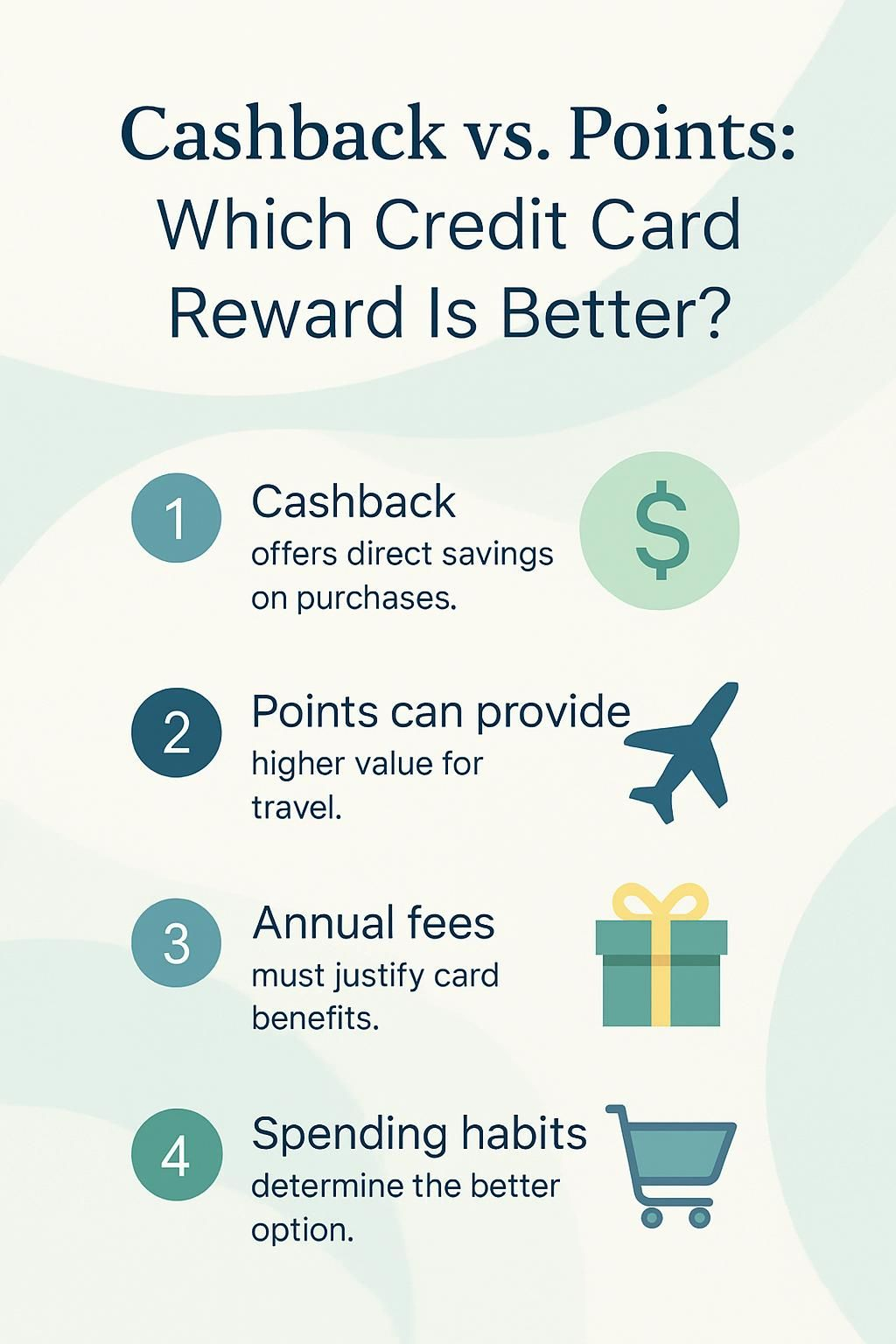Cashback vs. Points: Which Credit Card Reward Is Better?
Choosing the right credit card rewards can feel confusing, especially with so many options like cashback and points plans. Studies show that over 70% of consumers want better reward programs from their cards.
This post breaks down how both cashback offers and loyalty point strategies work, helping you see which option fits your financial goals best. Find out which reward system might give you more value.
Key Takeaways
- Cashback credit cards offer direct savings on purchases, with most programs providing simple redemption processes such as statement credits or direct deposits. Certain conditions might apply based on spending categories, which could lessen the earning potential for certain types of expenditures.
- Points-based credit cards can significantly augment travel rewards through partnerships with airline and hotel loyalty programs. Nonetheless, redeeming points often involves complex rules and limitations that can decrease their value compared to cashback options.
- Tactical use of credit cards can increase airline miles, involving selecting cards with high earn rates on specific purchases, exploiting sign-up bonuses, and aligning card usage with personal spending patterns. This strategy asks for a thorough examination of annual fees versus benefits received to ensure the best financial outcome.
- Individuals ought to consider their spending habits and lifestyle when deciding between cashback or points systems. Frequent travelers might gain more from points-based cards due to potential higher value on travel redemptions while those preferring straightforward rewards may find cashback cards more desirable.
- The decision between cashback and point rewards is determined by how effortlessly one wants to access and use their earned incentives. While cash offers immediate financial returns without limitations like blackout dates, points can offer higher value in specific scenarios such as travel but necessitate a proactive management approach for maximum gain.

Pros and Cons of Cashback Credit Cards

Cashback credit cards pay you back a percentage of your purchases as direct savings. Most people enjoy the ease of use and simple redemption, but each card sets its own earning rates and limits on cash rewards for certain spending types.
How easy is it to redeem cashback rewards?
Most rewards programs make cash rewards easy to use. You can request a statement credit or direct deposit with just a few taps on your bank’s app. Some cards let you set up automatic redemption, so you never have to think about it after activating the option.
A quote from an industry expert sums it up:
Cashback is as straightforward as it gets, turning points into real money.
You also get flexibility since there are no blackout dates or reward restrictions linked to most cashback offers. Top issuers like Chase and Citi process redemptions quickly, often within one to three days.
This simple process appeals to individuals who want fast access without extra steps or complex rules found in many loyalty programs.
What are the limits of cashback rewards for certain purchases?
Redeeming cashback rewards feels simple, but earning them can sometimes hit snags depending on the spending category. Credit card rewards programs often place caps on how much cash back you earn in certain groups such as groceries, gas stations, or restaurants.
For example, a luxury credit card might offer five percent cash back at supermarkets but only for the first $6,000 spent each year; after that limit, your earnings drop to one percent.
Some cards classify big purchases like jewelry or yacht rentals as “other” expenses and only pay base rates instead of promotional ones. Annual limits may apply to popular categories like travel or dining out too.
Many premium cards exclude specific merchants from maximum-earnings promotions by using merchant category codes determined by Visa or Mastercard networks. Reading these restrictions closely helps ensure you do not miss out on incentives offered by top financial institutions like American Express and Chase Private Client services.
Brands also reserve the right to change earn rates with little notice if their business strategies shift during economic changes or new offers launch mid-year.
Pros and Cons of Points-Based Credit Cards
Points-based credit cards offer strong travel rewards and can give you higher value through loyalty programs. These cards often feature many redemption options, but using reward points may take more effort than earning simple cash rewards.
How can points-based cards increase rewards for travel and partners?
Airline and hotel loyalty programs often boost the value of points earned on certain credit cards. Transfer partners like American Express Membership Rewards or Chase Ultimate Rewards let you move your points to more than a dozen airlines, including Delta SkyMiles and United MileagePlus, or top hotel programs such as Marriott Bonvoy.
Most transfer rates work at 1:1, so 100,000 reward points easily become 100,000 miles with an airline partner. This can stretch rewards further than cashback ever could.
Some premium cards also give bonus multipliers for travel spending. For example, using a Chase Sapphire Reserve card might earn three times the usual number of reward points on flights and hotels booked through their portal.
I once used my own Citi ThankYou Points to book a suite upgrade worth $900 at no extra charge because the transfer rate was so generous during a limited-time offer in April 2023. As Warren Buffett puts it,.
“Price is what you pay; value is what you get.”
By learning these tactics, frequent travelers can quickly maximize financial benefits with each purchase in select spending categories.
Why is redeeming points sometimes complex and restricted?
Credit card rewards programs often attach strict rules and limitations to loyalty points. Many issuers like Chase, American Express, and Citi require you to book travel through their partner portals or certain booking engines if you want the highest value for your reward points.
Blackout dates, expiration policies, and minimum thresholds can make it even harder to use those hard-earned miles or hotel points exactly how you would like. For instance, transferring Membership Rewards from American Express to airline partners may take several days and usually comes with transfer ratios that may reduce your total value.
Having managed a mix of high-tier cards myself, I have seen first-hand how redemption options sometimes seem broad but in practice are limited by seat availability on flights or specific room types at hotels.
Bonus multipliers often only apply within select spending categories or brands such as Marriott Bonvoy or United MileagePlus. Annual fees offer perks but do not always guarantee simple redemptions for all travel rewards enthusiasts who expect flexibility equal to cash back cards.
Next up: find out how the right credit card can maximize your airline miles for lavish trips.
How can you maximize airline miles with the right credit card?
Maximizing airline miles requires a strategic approach. Selecting the right credit card is crucial to earning more travel rewards. Here’s how you can achieve this:
- Choose cards offering high earn rates on purchases. Some cards provide multiple miles for every dollar spent, especially on travel and dining.
- Sign up for bonuses that add a significant mile boost. Many credit cards offer welcome bonuses that can range from 50,000 to 100,000 miles after meeting a minimum spend within the first few months.
- Use your credit card for all possible expenses to accumulate miles faster. Paying for everyday purchases, bills, and large expenses with your card can rapidly increase your miles.
- Pair your credit card with airline loyalty programs. This synergy allows you to earn both credit card points and airline miles simultaneously for the same flight booking.
- Take advantage of special offers and promotions from your credit card issuer or airlines. These often include additional mile earnings or discounts on bookings.
- Consider annual fees against benefits received. Cards with high annual fees might offer valuable perks like free checked bags or airport lounge access which justify the expense if used wisely.
- Pay attention to expiration policies for miles earned through your credit card to ensure you use them before they expire.
- Redeem miles strategically by comparing the cash price vs reward flights; sometimes paying with cash and saving your miles for more valuable redemptions offers better value.
- Diversify across multiple airlines through cards that allow transfer of points to various partners, increasing flexibility in redemption options.
- Stay informed about changes in reward programs as terms and benefits can evolve, affecting how best to earn and spend miles.
My own experience underscores these strategies’ effectiveness in enhancing mileage accrual through everyday spending, ensuring each purchase moves me closer to my next trip at minimal cost.https://www.youtube.com/watch?v=nY7th5_pTss
Factors to Consider When Choosing
Selecting the right rewards card depends on how you spend and which benefits matter most to you. Reward structures, annual fees, and spending categories all shape your long-term earnings from incentive programs or loyalty offers.
How do your spending habits and lifestyle affect your choice?
Big spenders who dine out often or shop at luxury retailers can earn significant rewards with credit cards that match their top spending categories. For example, Chase Sapphire Reserve offers extra points for travel and dining purchases, while Platinum Card from American Express gives preferred access to exclusive events and premium benefits.
Frequent travelers may value miles or loyalty points programs that enhance upgrades and offer perks in airport lounges.
Someone who prefers a simpler approach with fewer restrictions might find cash rewards more appealing. High-net-worth individuals often use multiple cards to maximize incentive programs across different types of spending such as flights, hotels, and everyday expenses.
I have used both cashback and reward points strategies and found that tracking which card earns the best rate for each purchase optimized my returns without much effort. Annual fees pay off fast if your lifestyle matches the card’s highest-earning categories or provides VIP experiences you already enjoy purchasing.
What role do annual fees and reward structures play?
Annual fees can shape the value of a credit card rewards program. Premium cards, such as Chase Sapphire Reserve or The Platinum Card from American Express, often charge $550 or more each year.
In exchange for these higher annual fees, issuers include perks like airport lounge access, elite hotel status upgrades, and statement credits for travel purchases. These bonuses can far exceed the fee if you use them; I once offset my Amex Platinum’s $695 annual fee with just one four-night stay at a luxury Marriott.
Reward structures direct how you earn points or cash rewards from every swipe. Some cards pay flat rates across all spending categories while others boost earnings in certain areas like dining or airfare.
For example, Citi Double Cash gives 2 percent back on everything but does not offer extra benefits on travel bookings or special events. The right mix of annual costs and reward programs depends largely on your financial goals and lifestyle choices.
The next factor to weigh is how your own habits might influence which type serves you best.
Conclusion
Choosing between cashback and points depends on your lifestyle and how you use credit card rewards. Cash rewards make it easy to see the financial benefits right away, while loyalty programs like airline miles or travel credits offer higher earning rates for frequent travelers.
Points-based cards can boost value if you enjoy luxury trips or premium experiences but often require more effort during redemption. Pick a reward program that matches your spending habits, so every purchase brings you closer to something valuable.
The best card gives back in ways that fit both your wallet and your adventures.
To learn more about maximizing your airline miles, visit how to maximize airline miles with the right credit card.
FAQs
1. What is the difference between cashback and points in credit card rewards?
Cashback refers to a percentage of your spending that you get back as money, usually credited to your account or given as a check. On the other hand, points are units earned per dollar spent which can be redeemed for goods, services, or experiences offered by the credit card company.
2. Which reward is better: cashback or points?
The “better” reward depends on individual spending habits and preferences. If you prefer simplicity and direct monetary return, cashback may be more suitable. However, if you’re interested in redeeming specific rewards like travel perks or exclusive deals at certain stores, collecting points might prove more beneficial.
3. Can I choose between getting cashback or earning points with my credit card?
Yes! Many banks offer different types of cards tailored towards either earning cash back on purchases made using the card or accumulating reward points that could be exchanged for various items.
4. How can I determine whether a cashback or point-based system will give me more value?
To figure out which system offers greater value; consider how much each point is worth when redeemed (this varies from one program to another), what kind of purchases earn extra rewards (some cards offer bonus categories), and how often these bonuses change.

 Previous Post
Previous Post Next Post
Next Post